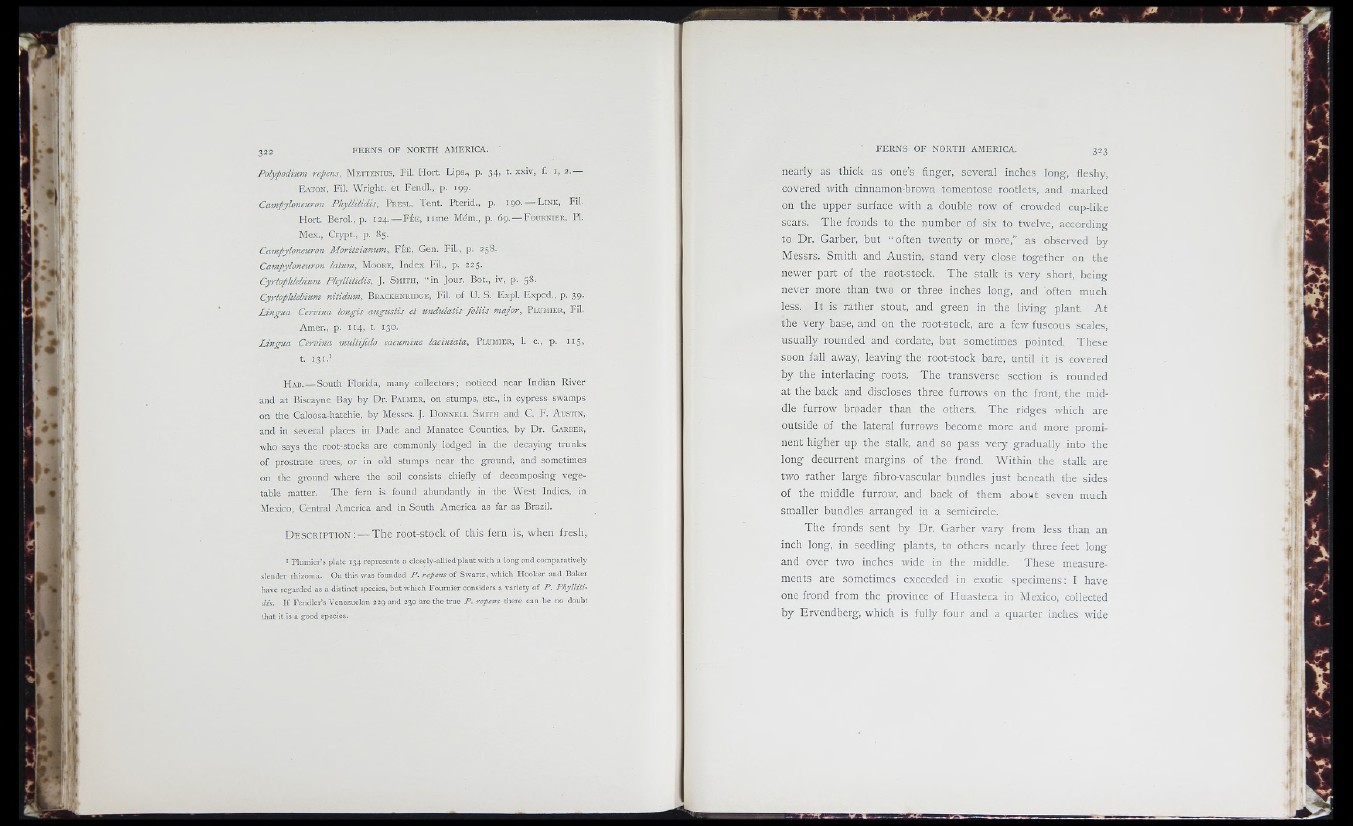
r
i t
W - ” 1
\ p j
t
i
Polypodium repcns, M e it e n iu s , Fil. H o r t . Lips-, p. 3 4 , t. x x i v , f. i , 2 .—
E aton, Fil. W r ig h t , et Fendl., p. 19 9 .
Campyloneuron P/iyllilidis, P r e s l , T e n t . P te r id ., p . 19 0 . — L in k , F il.
Hort. Berol., p. 1 2 4 . — Fée, urne Mém., p. 6 9 .— F o u r n i e r , Pl.
Mex., Crypt, p. 85.
Campyloneitron Moritzianum, Fée, Gen. Fil., p. 258.
Campyloneuron latum, M o o r e , Index Fil., p. 2 2 5 .
Cyrtophlebium Phyllitidis, J. S m it h , “ in Jour. Bot., iv , p. 58 .
Cyrtophlebium nitidum, B r a c k e n r id g e , Fil. of U. S. Expl. Exped., p. 39.
Lingua Cervina longis angustis et undulatis fo liis major, P lu m ie r , Fil.
Amer., p. 114 , t. 130.
Lingua Cervina multifido cactimine laciniata, P lu m ie r , 1. c ., p . 1 1 5 ,
t. i 3 if l
H a b .— South Florida, many collectors; noticed near Indian River
and at Biscayne Bay by Dr. P a lm e r , on stumps, etc., in cypress swamps
on the Caloosa-hatchie, by Messrs. J . D o n n e l l S m ith and C. F . A u s t in ,
and in several places in Dade and Manatee Counties, by Dr. G a r b e r ,
who says the root-stocks are commonly lodged in the decaying trunks
of prostrate trees, or in old stumps near the ground, and sometimes
on the ground where the soil consists chiefly of decomposing vegetable
matter. The fern is found abundantly in the West Indies, in
Mexico, Central America and in South America as far as Brazil.
D e s c r i p t io n ; — The root-stock of this fern is, when fresh,
I Plumier’s plate 134 represents a closely-allied plant with a long and comparatively
slender rhizoma. On thi.s was founded P . re fen s o f Swartz, which Hooker aud Baker
have regarded as a distinct species, but which Fournier considers a variety o f P . P h y llit idis.
I f Fendler’s Venezuelan 229 and 230 'are the true P . repens there can be no doubt
that it is a good species.
I A
nearly as thick as one’s finger, several inches long, fleshy,
covered with cinnamon-brown tomentose rootlets, and marked
on the upper surface with a double row of crowded cup-like
scars. The fronds to the number of six to twelve, according
to Dr. Garber, but “ often twenty or more,” as observed by
Messrs. Smith and Austin, stand very close together on the
newer part of the root-stock. The stalk is very short, being
never more than two or three inches long, and often much
less. It is rather stout, and green in the living plant. At
the very base, and on the root-stock, are a few fuscous scales,
usually rounded and cordate, but sometimes pointed. These
soon fall away, leaving the root-stock bare, until it is covered
by the interlacing roots. The transverse section is rounded
at the back and discloses three furrows on the front, the middle
furrow broader than the others. The ridges which are
outside of the lateral furrows become more and more prominent
higher up the stalk, and so pass very gradually into the
long decurrent margins of the frond. Within the stalk are
two rather large fibro-vascular bundles just beneath the sides
of the middle furrow, and back of them about seven much
smaller bundles arranged in a semicircle.
The fronds sent by Dr. Garber vary from less than an
inch long, in seedling plants, to others nearly three feet long
and over two inches wide in the middle. These measurements
are sometimes exceeded in exotic specimens: I have
one frond from the province of Huasteca in Mexico, collected
by Ervendberg, which is fully four and a quarter inches wide
I
4 IJ
r